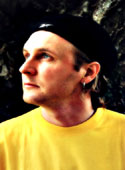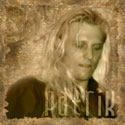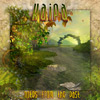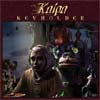Chapters >> 1 - 2 | 3 - 4
Hans realised that he needed an extra-talented drummer to play these often complex arrangements, but he also wanted someone bringing energy, fantasy, improvisation and personality to the music. For a long time Hans had been a big fan of Morgan Ågren for his brilliant technique, and imaginative and idiosyncratic drumming. So in the spring of 2000 Hans contacted Morgan and offered him to be part of this project. Hans sent the songs to Morgan, who accepted. The recordings were made at the UAE Magnetofon Studio in Stockholm 11 - 22 September 2000 by Hans and Morgan.
As soon as the drums were recorded Roine added most of the guitars at Cosmic Lodge during September and October 2000 using mostly his old Gibson Les Paul Gold Top -52 and his Gibson ES-175 to create the special vintage Kaipa trademark sound. Also a lot of similar 70's effects like the phaser and wa-wa were used.
After this, they were forced to take a long break from the recording process because of Roine's work with "The Flower Kings" and "Transatlantic". Hans met Jonas Reingold, after hearing him in Flower Kings on "Space Revolver", in the autumn of 2000 when he presented the songs for him, but not until the beginning of 2001 was Jonas available to add his bass parts. The choice of Jonas was by all means a good solution as he is a brilliant bass player bringing new dimensions to the songs.
One of the songs for the album was intended to be sung by a female. Hans considered Sara Isaksson to be perfect to interpret the song "A road in my mind". He contacted her and presented the song. She thought it was a nice song that gave her a fairy-tale feeling, but declined, saying that she wanted to concentrate on working with her own new songs.
The collaboration with Michael wasn't as successful as they had intended it to be. Hans had written words to some of the songs when they started, and while he was waiting for signs of progress from Michael, he wrote the lyrics to more songs. They made a demo recording of the vocal parts in August 2000, and in February 2001 they made what they thought would be the final recording. Unfortunately this was not good enough. They both realized that Michael, who in fact is a brilliant singer, didn't fit properly in this special musical situation. So they decided to cancel this collaboration and instead join forces in "Hagen" sometime in the future.
So, in Mars 2001 Hans and Roine had to face the fact that they were left standing with a complete album but with no singer to finish the work. A lot of names were put forward as a potential solution to this problem: Roine came up with the singer of unknown band Carp Tree, Patrik Lundström of Ritual and Ola Salo of The Ark, but finally Hans decided to make Patrik an offer. Patrik accepted and the vocals were recorded at HGL Studio in just two days, 28 - 29 May 2001. Patrik's high vocal timbre brings a dimension to the music which is close to the sound of the early Kaipa. As he is a professional and brilliant singer he also brought a lot of new energy to the songs. The song "Notes from the past part II" was originally recorded and meant to be sung by Hans, marking a difference between the two versions of the song, but when Hans heard Patrik sing the first part he was overwhelmed and decided to change this decision.
Hans happened to ask Patrik if he knew any female singer who could to perform the song "A road in my mind". Hans wanted a singer able to make a personal interpretation, to bring a lot of energy and feeling to the song as a contrast to the soft and sweet little melody. After some searching Patrik returned on 15 June 2001 to the studio with Aleena. She performed the songs in her sophisticated, personal manner, with Hans and Patrik providing a compact and complete smiling support.
Many of the basic keyboard tracks recorded simply as a momentary demo are still in use in the final result, proving the worth of the original inspiration. During the autumn 2000 Hans completed most of the keyboard work and added the Hammond organ, the Yamaha CP-70 Piano and the Yamaha CS-60 Synthesizer, bringing the final touch to the recordings.
When the recording was completed in the summer of 2001, Hans contacted Per Nordin. Hans knew Per as an obstinate musician from the 70's, but he didn't know anything about his art talent until he saw the cover of the first Transatlantic album. They discussed the possibility of Per doing the artwork for the album cover and properly reflecting the musical content.
To give Per a chance to form his own opinion of the music they listened to the raw mix of the album. After some minutes of silence Per looked at Hans and said: "Why are you talking about a "green glass"? This is irrefutably KAIPA, and this is what all your old fans have been waiting for." So Hans and Roine discussed this, and a few days later they decided to use the name Kaipa again, considering this as a trademark for the content of the album, as well as a good way to nudge it into the Kaipa limelight, and getting more people to hear it. It was also meant as a tribute to the reunion of the main forces of the original band, two musicians bringing their unique forces together again in chemistry. Roine, who already had two bands to write songs for and play with, agreed to reuse the name Kaipa and thought this a good solution, in spite of his lack of input to the actual compositions as he obviously had hands full with his own successful projects anyway. Through his way of playing, Roine contributed much to what was the Kaipa sound and came also with valuable input during the final arrangement and mixing stage.
The album "Notes from the past" proves it's possible to make a bridge between the past and present, forming a new progressive music that has as much similarities with the old Kaipa records as it has differences.
Chapter 4: The making of "Keyholder"
Hans had a basic idea to use the same musicians as on "Notes from the past".
He considered this combination so magical and successful, so he didn't see any reason to change this. All persons were informed at an early stage about the plans and everybody wanted to participate thinking it was a great idea.
One important difference this time is the wider use of all the voices in the band.
This means that on several songs Patrik, Aleena, Hans and Roine are all singing together.
The album was recorded between January and Mars 2003 in HGL & Cosmic Lodge Studios Uppsala, The UAE Magnetofon Studio Stockholm and Reingold Studio Malmö. The mixing took place at Cosmic Lodge in May 2003.
The original artwork is made by Jan Ternald, an artist and also a former musician. (During the 70's he played in the Swedish bands "Älgarnas Trädgård" and "Fläsket Brinner" and did cover-art for Bo Hansson.)





Chapters >> 1 - 2 | 3 - 4